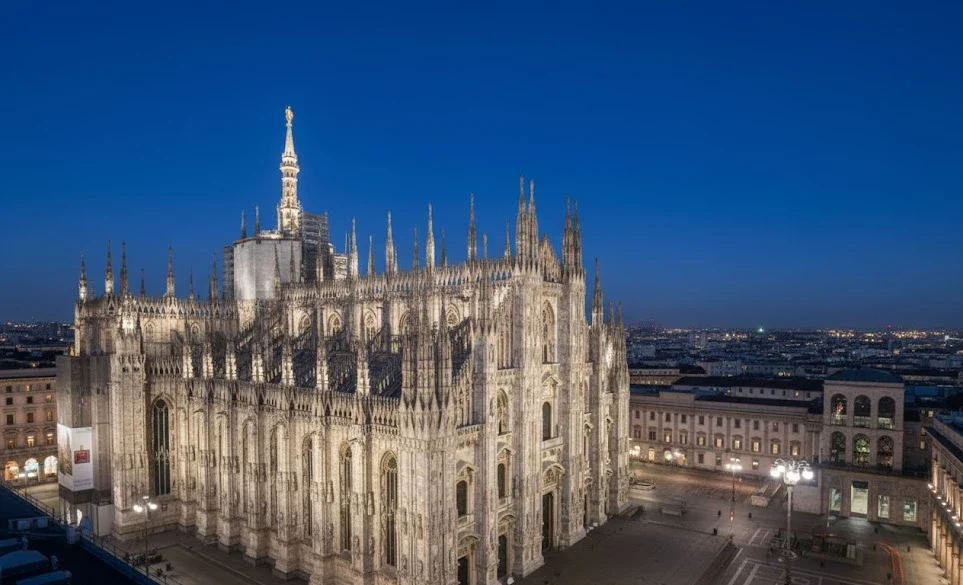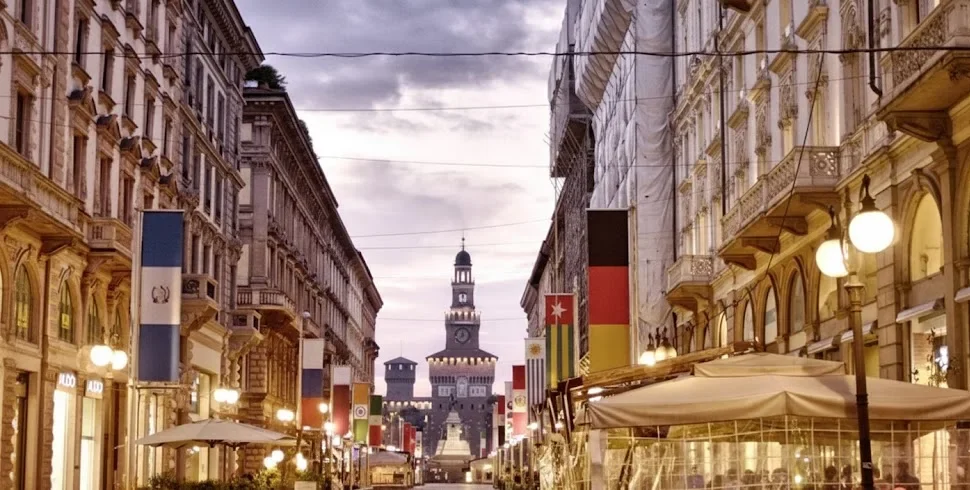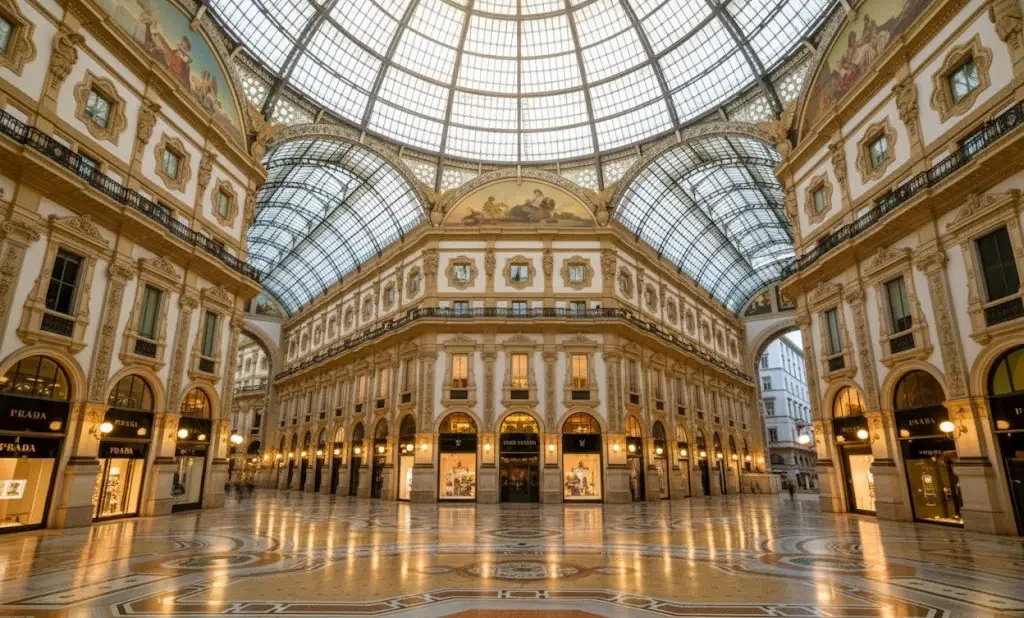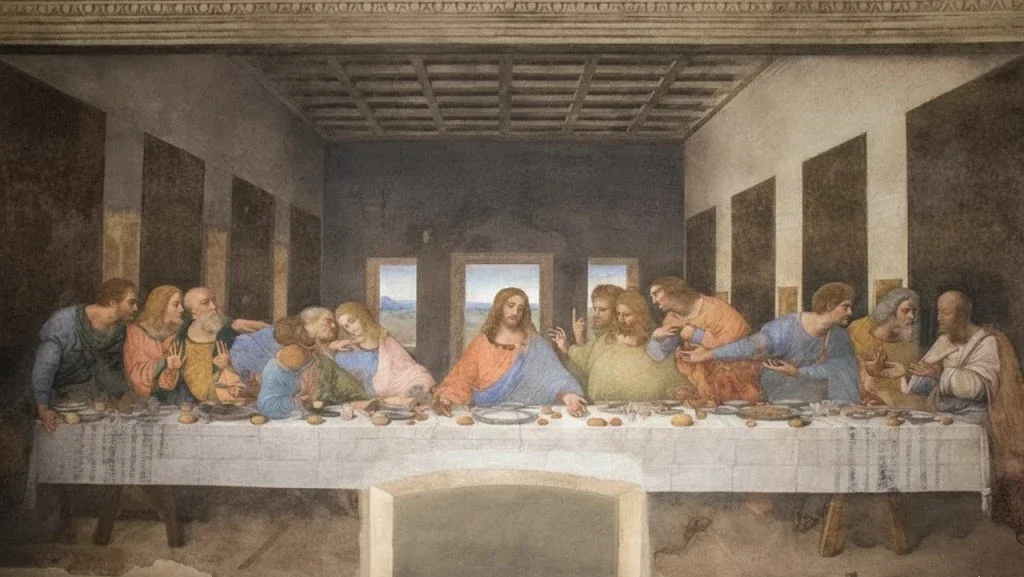We’ll tell you what you can do near the Duomo, for all types of tourists: young adults, those with limited time, those who can explore every detail…
Standing in the Piazza del Duomo feels a bit like standing at the heart of Milan itself. Everything radiates from here – not just the metro lines and busy streets, but the city’s entire cultural pulse. You’ve got centuries of art, fashion, food, and architecture all clustered within walking distance. The beauty of this area is that you don’t need days to experience it, you just need to know where to look.
And here’s the thing: this isn’t about ticking boxes on a tourist checklist. It’s about understanding why Milan has always been one of Europe’s most powerful cities. When you walk these streets, you’re following the same paths that Renaissance artists, opera legends, and fashion icons have walked. Pretty incredible when you think about it, right?

Let’s start with the obvious: the Duomo is staggering. When you first approach it, the sheer scale will hit you – we’re talking about the third-largest church in the world, with a facade covered in 3,400 statues and 135 spires reaching toward the sky.
But there’s something most tourist guides don’t tell you, and that is that the Duomo is not just the building you see above ground. Beneath your feet lies the Baptistery of San Giovanni alle Fonti, an archaeological site that reveals Milan’s early Christian roots. Think 4th-century foundations, ancient mosaics, and the exact spot where Saint Ambrose baptised Saint Augustine in 387 AD. It’s like peeling back layers of history, adding a whole new dimension to your visit.
Inside the cathedral itself, you’ll find yourself craning your neck at those impossibly high vaulted ceilings. The stained glass windows – some of the largest in Christendom – cast colored light across the marble floors.
Look, I’m going to be direct with you: skip the interior tour if you must, but do not miss the rooftop of the Duomo Milan. Obviously, the entire Duomo is worth a visit, but the rooftop is where the Duomo transforms from impressive to absolutely unforgettable. Up here, you’re walking among a forest of spires, flying buttresses, and marble statues, with Milan sprawling beneath you in every direction.
The star of the show is the Madonnina, the golden statue of the Virgin Mary that’s topped the cathedral since 1774. Standing 108.5 meters above street level, she’s become Milan’s symbol – so much so that for decades, no building in the city was allowed to be taller than her. The views from up here explain why Milan has always been such a powerful city: you can see the Alps on clear days, understand the city’s strategic position, and get a sense of how it connected Northern Europe to the Mediterranean.
You have two options to get up:
Here’s where a little planning saves you hours of frustration. First, the dress code is strictly enforced. No bare shoulders, no shorts above the knee, no low-cut tops. They’re not messing around – you’ll see people turned away at the entrance. Bring a scarf or light cardigan if you’re wearing something remotely revealing, especially in summer.
For tickets, the Duomo Complex Pass is your best bet. It includes the cathedral interior, the terraces, the archaeological area, the Duomo Museum, and San Gottardo Church. You can choose the pass with stairs or elevator access to the roof (prices differ by about €5-7). Single tickets exist, but they’re a false economy if you plan to see more than just the cathedral floor.
And here’s the critical part, book ahead! The online queue is nothing compared to the line that snakes around the plaza on busy days. We’re talking potentially two hours of standing in the sun versus walking straight to your time slot. The Duomo sells out during peak season, and even off-peak, pre-booking means you control your schedule rather than losing half your morning to a queue.
If you’re a young tourist wondering what to do near the Duomo, Milan offers two distinct shopping experiences that reflect the city’s dual personality. Via Monte Napoleone (the world’s most expensive shopping street in 2024) brings together all the Italian luxury brands (Gucci, Prada, Versace, Armani) in 350 metres of pure glamour. Even if it’s just to window shop, dress up and treat it like an open-air fashion museum. The surrounding streets (Via della Spiga, Via Sant’Andrea, Via Manzoni) complete the ‘Quadrilatero della Moda’. On a budget? Take a bus to the Serravalle Designer Outlet for discounts of 30 to 70 per cent on the same brands, or head to Via Torino, near the Duomo, Milan’s bustling shopping street lined with Zara, H&M and young locals in search of affordable trends.

But Milan’s real magic happens at aperitivo (6-8pm), the city’s sacred ritual that goes far beyond happy hour. Order one drink (€10-15), try a Negroni Sbagliato invented here, or the classic Aperol Spritz, and access spreads ranging from chips and olives to full buffets with pasta, cheeses, and hot dishes. Some places offer “apericena” with enough food to replace dinner. The point isn’t free food or getting drunk; it’s unwinding with friends over slowly-sipped cocktails, watching Milan transition from work mode to evening relaxation.
Experience this ritual at its best in Navigli, the historic canal district that transforms at sunset into Milan’s social epicenter. Bars line the waterfront, lights shimmer on the water, and crowds gather on canal walls as the sky turns orange and pink. Bar-hop along Naviglio Grande—grab a spritz at one spot, sample another buffet down the way, repeat. Don’t miss Vicolo dei Lavandai, a tiny alley with a beautifully-lit 19th-century washhouse that tourists overlook. Visit on the last Sunday of any month for a massive antique market. By 7pm, whether in sleek Brera lounges or student hangouts, you’ll see Milan shed its business armor and embrace la bella vita—the beautiful life that makes this city unforgettable.
Step through the archway from the Piazza del Duomo and you’ll find yourself in what locals call Milan’s “drawing room”, and they’re not exaggerating. The Galleria Vittorio Emanuele II is a must see if you want to understand Milan’s character.
Built between 1865 and 1877, this wasn’t just a shopping arcade – it was a statement. Italy had just unified, and Milan wanted to announce itself as a modern European capital. Architect Giuseppe Mengoni created something revolutionary, a four-story gallery crowned by a spectacular iron and glass dome that floods the space with natural light.
Look up at that octagonal dome where the two galleries intersect. When it was completed, it was praised for its unprecedented scale. This was also Milan’s first building to have electric lighting, making it a beacon of progress in every sense. The engineering was cutting-edge for the 1870s, using iron and glass in ways that rivaled anything in London or Paris.
But here’s where it gets interesting, because the floor is a political manifesto. Under the central dome, you’ll see four intricate mosaics representing the coats of arms of Italy’s capitals – Turin (a bull), Florence (a lily), Rome (the she-wolf with Romulus and Remus), and Milan (a red cross on white). This wasn’t random decoration; it transformed the Galleria’s floor into a symbolic map of the new nation.
Now, about that bull. There’s a tradition that’s been wearing a literal hole in the mosaic: place your right heel on the bull’s, ahem, most sensitive anatomical part, and spin three times for good luck. You’ll see locals and tourists queuing up to do this, and the constant spinning has indeed created a visible depression in the marble. For a full year of fortune, tradition says you should do it at midnight on New Year’s Eve. Superstitious? Maybe. Fun? Absolutely.

The Galleria is a living museum of Milanese elegance, housing some of the city’s oldest and most prestigious establishments, including the historic Biffi Caffè (founded in 1867) and the Borsalino hat shop. But no institution better embodies its spirit than Camparino in Galleria. Opened in 1915, it became the epicenter of the Milanese aperitivo. With its sumptuous Art Nouveau furnishings, it remains a historic landmark and one of the world’s best bars.
Even if you’re just window shopping at Prada, Gucci, or Louis Vuitton, the experience here isn’t just about luxury goods. It’s about pausing for an espresso at a historic bar, admiring the architecture, and watching the world go by. This is where you see Milanese elegance in practice.
Housed in the Palazzo dell’Arengario, a stark 1930s building from the Mussolini era, this museum is dedicated to 20th and 21st-century Italian art. The permanent collection features over 300 masterpieces tracing modern art’s evolution, with a heavy emphasis on Futurism and key artists like Giorgio de Chirico, Piero Manzoni, and the Arte Povera movement.
Housed in the Palazzo dell’Arengario, a stark 1930s building from the Mussolini era, this museum is dedicated to 20th and 21st-century Italian art. The permanent collection features over 300 masterpieces tracing modern art’s evolution, with a heavy emphasis on Futurism and key artists like Giorgio de Chirico, Piero Manzoni, and the Arte Povera movement.
We’re talking major retrospectives: Picasso, Goya, El Greco, Cézanne, Man Ray. The exhibitions change regularly, and you don’t want to show up expecting Renaissance masters only to find contemporary photography (or vice versa). The official website lists upcoming shows months in advance, so you can plan accordingly.
Just minutes from the Duomo, at Piazza Pio XI, sits a cultural treasure that flies under most tourists’ radar, the Pinacoteca Ambrosiana. Founded in 1621 by Cardinal Federico Borromeo, it’s Milan’s oldest museum and holds collections of incalculable artistic and historical importance.
The crown jewel? Leonardo da Vinci’s Codex Atlanticus, the largest existing collection of Leonardo’s original writings and drawings. These pages offer a direct window into the genius’s mind, exploring everything from flight studies and war machinery to botany, mathematics, anatomy, and musical instruments.

This is one of the most famous artworks in the world, located in the refectory of the Santa Maria delle Grazie convent. Because of the mural’s extreme fragility, access is strictly controlled.
You must book tickets months in advance. We aren’t talking weeks. The official ticket system releases tickets on a quarterly basis, and they sell out almost instantly.
The Teatro alla Scala is not just an opera house; it’s a world-renowned cultural institution. While attending a performance is a bucket-list experience, you can also visit the adjacent Museo Teatrale alla Scala (Theater Museum). The museum ticket often grants you a peek inside the sumptuous red-and-gold auditorium from one of the boxes (as long as a rehearsal isn’t in progress).
Outside, the Piazza della Scala is a destination itself. In its center stands an imposing monument to Leonardo da Vinci, surrounded by four of his disciples. Facing the theater is the Palazzo Marino, Milan’s elegant 16th-century city hall.
This is Milan’s answer to the Uffizi Gallery in Florence, though often less crowded than you’d expect for the quality of art inside. Housed in the beautiful Palazzo Brera (which also holds an art academy), this is the city’s premier gallery for Renaissance and Baroque art.
This imposing brick fortress was once the residence and citadel of Milan’s dukes. Today, it’s been transformed into a cultural center serving a dual function, its extensive courtyards and grounds are free to enter, offering a tranquil oasis and public space for relaxation, while its walls house a network of Civic Museums.
Hidden just steps from the bustling Duomo is a tiny, quiet square that feels like a portal to the Middle Ages. The Piazza dei Mercanti (Merchants’ Square) was the true commercial and administrative heart of medieval Milan. The square is dominated by the Palazzo della Ragione (1233), the old courthouse whose open ground-floor portico once housed the city’s market.
Opposite it is the elegant black-and-white marble Loggia degli Osii (1316), from whose central balcony (parlera) magistrates would announce edicts to the citizens below. It’s a stunning, quiet escape that shows you what Milan looked like long before the Duomo was finished.
TICKETS
When you visit the Duomo in Milan, this ticket gives you access to important attraction. The ticket is valid for three days from the date you…
TRAVELER INFORMATION
The main cathedral and the archaeological area are open every day from 9:00 AM to 6:00 PM. Duomo Milan’s opening hours are the same…
TRAVELER INFORMATION
The main cathedral and the archaeological area are open every day from 9:00 AM to 6:00 PM. Duomo Milan’s opening hours are the same…
DUOMO MILAN INFORMATION
The Duomo di Milano also known as the Milan Cathedral is an amazing architectural wonder. It is one of the largest Gothic cathedrals…
